Coolmountain House
Houses within 15km of this house
Displaying 33 houses.
Houses within 15km of Coolmountain House
Displaying 33 houses.
| House name | Description | |
|---|---|---|
| Curraghalicky | Edward Powell was leasing this property to Edward Ellis at the time of Griffith's Valuation, when it was valued at £7 10s. The site is now occupied by substantial modern farm buildings. | |
| Dromdaleague House | At the time of Griffith's Valuation, Rev. Thomas Tuckey was leasing this property from George Bird, when it was valued at £12 5s. Lewis records it as the seat of Rev. T. Tuckey, rector, in 1837. | |
| Rock Castle Mill | John and James Gillman were leasing this property to John Hazel at the time of Griffith's Valuation, when it was valued at £8 and the mill at £52. In 1837 Lewis had noted it as the property of Mr. Heazle. It does not appear on the later 25" Ordnance Survey Map, suggesting perhaps, that it had ceased operations by the end of the nineteenth century. | |
| Lakemount House | Samuel Millner was leasing this property to Benjamin Millner at the time of Griffith's Valuation, when it was valued at £ 6 10s. In 1814 Leet notes Lakemount as the seat of George Beamish. There is still a house at this site. |

|
| Kilcaskan Castle | At the time of Griffith's Valuation, William O'Neill Daunt held this property in fee when it was valued at £32. In 1837 Lewis notes that it was held by Daunt and describes it as " a handsome castellated mansion". Both Taylor and Skinner and Wilson refer to it as a seat of the Daunt family in the 1780s. In 1894 Slater referred to it as the seat of Achilles Daunt. In 1906 it was also owned by Achilles Daunt and valued at £12 10s. The Irish Tourist Association Survey of 1944 referred to it as the residence of Miss M.O'Neill-Daunt. It is still extant. |

|
| Carrignacurra Castle | Masters esq was the occupier of Carronacurragh or Carrignacurra in the 1770s and 1780s. Jasper Pyne is recorded as the occupier of the castle at the time of Griffith's Valuation and it was held by him in fee. The buildings were valued at £17. | |
| Carrigboy | E. Barrett resided at Carriguoy, parish of Kilmichael, in 1837. At the time of Griffith's Valuation John E. Barrett occupied this house valued at £15.10 shillings and held by him in fee. A lithograph of the house, with the hunt assembled outside the hall door, is included in the rental. | |
| Kilbarry House | The Barrys were resident at Kilbarry from at least the latter part of the 18th century. J. Barry was occupying the house in 1837 and Nicholas Barry in the early 1850s when it was valued at £11. Nicholas Barry held the property from Henry Hatchell and Thomas Leader. A house is still extant at the site. | |
| Dromcarra House | In 1837 Lewis records J. Barter as resident at a house called Lee Mount in the parish of Inchigeelagh. The name Joseph M. Barter of Dromcarra House appears in the list of subscribers to Lewis. Thomas Barter held a house valued at £11.5 shillings in fee in Dromcarra North at the time of Griffith's Valuation. John Barter was resident at Droumcarra in the 1870s and John William Barter in 1906. A house still exists at the site. | |
| Boyle Grove | Boyle Grove was the residence of William Boyle in 1814 and of J. Boyle in 1837. The 1821 Census for Dromcarra records William Boyle, a gentleman farmer aged 65 and his wife Sophia, their two sons, William and James, and their daughters, see http://myhome.ispdr.net.au/~mgrogan/cork/inch_1821_cen.htm#Dromcarra By the time of Griffith's Valuation the house was occupied by Devonshire Hawkes who held it from the Court of Chancery. It was valued at £12.15 shillings. In March 1852 Boylesgrove, the estate of William Boyle, was advertised for sale. The rental records that the house was let to Devonsher P. Hawkes for 7 years in 1849 by the Court of Chancery. A house still exists at the site. | |
| Gortanimill House | In the mid 19th century this house was the residence of Herbert Baldwin MD and held by him in fee, valued at £24. It was included in the proposed sale of Herbert Baldwin O'Sullivan's estate in 1889 when the sale notice described it as "an excellent residence in very good repair". In 1944 the Irish Tourist Association survey refers to it as "formerly the residence of Dr. Baldwin, now occupied by Mr. Lynch, NT" This house is now demolished. | |
| Capeen | Richard Hungerford was leasing this property to Henry Hungerford in 1851 when it was valued at almost £10. Labelled Cappeen on the 1st edition Ordnance Survey Map. An enlarged building is named Cappeen House on the 25-inch map of the 1890s. A house still exists at the site. | |
| Carrigmore House (Kinneigh) | James Lysatt [Lysaght] held a property in fee here, valued at £46, at the time of Griffith's Valuation. Bence Jones states that it was built in 1842 by James Lysaght on the site of an earlier house known as Connorville, which had been purchased by Lysaght from the Connor family. In 1837 Lewis had referred to it as "the deserted and dilapidated mansion of the O'Connors." In 1783 Taylor and Skinner had indicated Connorsville as a seat of the Connor family as had Wilson in 1786. An adjacent smaller house, known as Laurel Hill, was held by Adderley Bernard in 1851. Carrigmore House and 312 acres, the estate of James Lysaght, were advertised for sale in July 1853. A lithograph of the house is included in the sale rental. Lyons indicates that the estate was sold privately to James L. Holmes. Carrigmore and Laurel Hill were offered for sale in the Landed Estates Court in 1876, as part of the sale of the Holmes estate. Donnelly states that it was burnt in October 1920 during the War of Independence when it was the property of James H. Morton. The house is now derelict. | |
| Fort Robert (Kinneigh) | Described by Lewis in I837 as a "handsome residence" then occupied by Mrs. [O'] Connor. In 1851 it was leased by George Fuller from Mary Longfield [O']Connor and valued at £18. By the mid 1860s it was in the possession of Thomas Kingston Sullivan. The sale rental of 1867 records that Fort Robert had been "allowed to get out of repair, but is beautifully situated". It appears to have become ruinous by 1890s. The Irish Tourist Association Survey of 1944 stated that the ruin was the property of Judge Henry Connor and also that the house had been associated with Art [O']Connor, United Irishman. | |
| Drinagh Mills | William Scott was leasing a house and flour mills from Hibernicus Scott in 1851 when the buildings were valued at over £40. It is not labelled as a mill on the 25-inch map of the 1890s. Farm buildings exist at the site now. | |
| Kippagh Lodge | Mary Long was leasing this property from John Bryan in 1851 when it was valued at £10+. It is still extant. | |
| Ballymana House | In 1851, James Bryan was leasing this property valued almost £9 from Samuel Townsend. It is labelled Ballymana House on the 25-inch map of the 1890s. It is still extant and occupied. | |
| Ballyhalwick House | Leased by William Norwood from the Townsend estate in 1851 when it was valued at £13. Noted by Slater as the residence of William Norwood in 1894. The original house is not extant. |
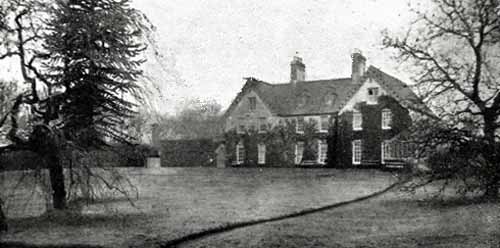
|
| River View (Dunmanway) | Rev.John Meade was leasing this property from William Norwood in 1851 when it was valued at almost £10. Adam N. Meade of Riverview, Dunmanway, owned 529 acres in county Cork in the 1870s. In 1894 Slater records Riverview as the seat of Rev. George Deacon. A house still exists at this site. | |
| Bridgemount House (Dunmanway) | Leased by Daniel Connor Jun. from Daniel O'Sullivan at the time of Griffith's Valuation when it was valued at £10 10s. A house still occupies the site. | |
| Manch | Held in fee by Daniel Connor at the time of Griffith's Valuation, when it was valued at £40. Lewis describes it as "an elegant villa four miles from the town, situated on a terrace, and surrounded with a highly cultivated demesne" in 1837. The Irish Tourist Association Survey of 1944 noted that it was then the residence of Circuit Court Judge Henry L. Connor. Bence Jone notes that the house was gutted by fire in 1963 but afterwards rebuilt. Still in the possession of the Conner family in the late 20th century. |

|
| Brookpark House (Dunmanway) | A property in the town of Dunmanway leased by Martha and Catherine Cox to John Hamilton in 1851 when it was valued at £16. It is still extant and well-maintained. |
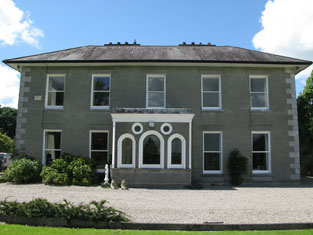
|
| Cloonties House | Mary Gillman was leasing this property from Jacob Biggs in 1851 when it was valued at £10 15s. There is still an extant house at the site. | |
| Woodbrook House & Darkwood Mill | Herbert Gillman was leasing a property at Cloontiquirk from the Cox estate in 1851 when it was valued at £25 10s and included a mill (W224535). The house is labelled Woodbrook on both the 1st-edition and 25-inch Ordnance Survey maps and is still extant and occupied. In 1943 the Irish Tourist Association Survey stated that it was the residence of Robert Atkins and had formerly been used as a convent by the Sisters of Charity. |
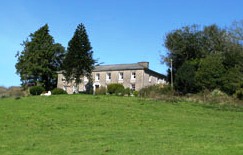
|
| The Manor House (Dunmanway) | Noted by Lewis in 1837 as " a handsome building, erected by the late H. Cox and now the residence of his family" In 1851 occupied by Martha and Catherine Cox and valued at £18. It replaced an earlier house built by Sir Richard Cox, Lord Chancellor of Ireland, at the end of the seventeenth century. Wilson describes this earlier property in 1786 as "adorned with handsome avenues and good plantations". Later the property of the Lucas family, In 1944 the Irish Tourist Authority Survey reported that it was the residence of Mr. T. O'Sullivan. |
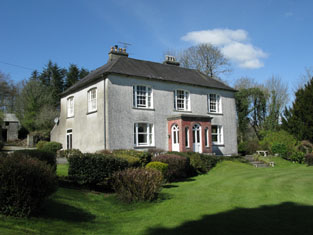
|
| Coolkellure House (Hill Farm) | Held in fee by Major General Shuldham in 1851 when it was valued at almost £17. It is labelled Hill Farm on the 1st edition Ordnance Survey map but as Coolkellure House on the 25-inch edition of the 1890s. It is still extant and part of a large farm.The National Inventory of Architectural Heritage describes it as a late Victorian House designed by Henry Hill. In 1943 the Irish Tourist Association Survey noted that the original house had burned down in 1920 and that this house replaced it. |
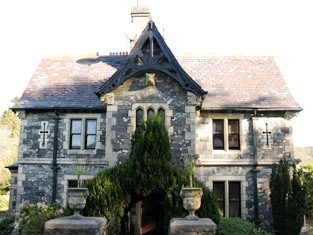
|
| Kilronane | In 1851 Joseph Bennett was leasing this property to John Jago when it and the adjacent mill were valued at £14. In 1837 Lewis referred to it as the seat of N.B. Jagoe. In the 1870s it was a Tuckey residence. There is still an extant house at the site. | |
| Milane House | Leased from Rev. John D. Beecher by Thomas Gilman at the time of Griffith's Valuation, when it was valued at £11 15s. A house still exists at this site. | |
| Prospect Hill (Dunmanway) | Elizabeth Bryan was leasing this property from the Cox estate in 1851 when it was valued at £22. There is still an occupied house at the site. | |
| Underhill Cottage | Held from Benjamin H. Holmes by William Hayle in 1851 when it was valued at £13. Now demolished. | |
| Woodlands (Dunmanway) | A house built after the publication of the 1st edition Ordnance Survey map in 1840. Leased by William Wright from the Cox estate in 1851 when it was valued at £8+. It is labelled Woodlands on the 25-inch map of the 1890s. A house still exists at the site. | |
| Carriganass Castle | Held by William O'Sullivan from the Bantry estate in 1852 when it was valued at £15 10s. Lewis refers to it as the seat of W. O'Sullivan in 1837. Slater refers to it as the seat of J.E. Barrett in 1894. The house takes its name from the original O'Sullivan castle located a short distance away. | |
| Carbery House (Dunmanway) | At the time of Griffith's Valuation, Francis Fitzmaurice was leasing two substantial houses at Sackville Street, Dunmanway, from Martha and Catherine Cox. One of these, valued at over £18, was leased to Rev Robert Molesworth, while Fitzmaurice was occupying the second, valued at over £15. In 1944 the Irish Tourist Association Survey referred to Carbery House "formerly occupied by Lord Carbery and now the residence of Mr. Smith". It is still extant. |
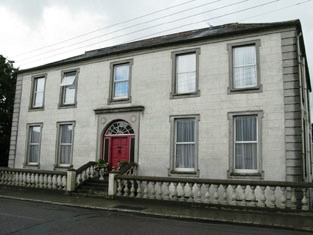
|

